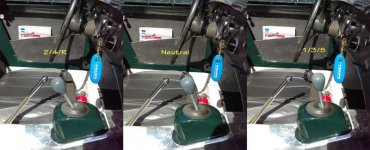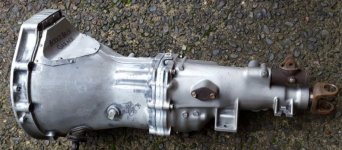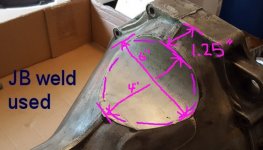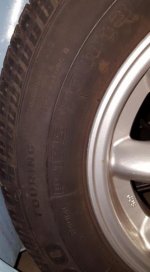PROMISED WRAP-UP (or nearly so):
With the full project complete (a month or two ago), here are a few observations related to performance. First, as a reference point, I have a 1275 engine and now have a Datsun 5 speed transmission (and Datsun clutch) WITH a 3.9 differential (which is the combination that started this lengthy thread). Thanks, too, for everyone's input along the way.

The gains:
a) syncho into first gear (more useful than I thought it would be)
b) beefy Datsun clutch (assembly and disk) with far superior throw-out bearing
c) tight, and many say "bullet-proof", transmission
d) quieter operation
e) much lower revs at high speeds (3.9 diff using the overdrive 5th gear) - though the 3.9 diff probably made the biggest difference in this regard
f) nice safety lock-out feature making it impossible to downshift from 5th into reverse (no biggie)
g) really accurate speedometer readings... and I don't know if this 90 degree adapter is a one-to-one thing
h) everything looks the same (unless you crawl under the car)
The shifting definitely feels different, but that was expected. It's "tight" and the throw seems shorter (especially from neutral to first). Also the clutch has an even and somewhat stiffer pedal feel throughout its range (and works very well with the 3/4" master that allows for more feathering - I'm told that sticking with the 7/8" MC makes the pedal depression very much stiffer and with more of a on/off action). The shifter boot has presented with the predicted difficulties (i.e., even with some glue it just doesn't want to stay put); I may widen the opening and go with the big-Healey boot afterall.
Starting definitely sounds different with the gear-reduction starter.
So, what sort of readings do I see? Unfortunately, my tach cable broke just before taking measurements. However, I can report that the speedeometer is nearly
SPOT ON (checked using the GPS app on my phone); it was amazing - probably accurate to within a mile or two per hour (up to 45mph - didn't go faster today)! I'll report back on revs when I fix the tach issue. Anyway, driving at highway speeds now seems effortless.
As others have written, I wouldn't go back to the original tranny and diff.

***************************
COST: well now, this depends entirely on the sources of parts and labor (should one choose to use a shop).
As I originally reported, I was EXTREMELY fortunate to get a Paul Asgiersson (formerly "Morris Services") conversion kit from a old friend for what I think was nearly nothing (and this would be essentially the same kit that Gerard now offers - which I believe to be superior to others). I don't know what a conversion kit currently goes for, but I suspect you can quickly get to $1400+ (if you make related changes). Then, these 1979-1982 Datsun 210 transmissions (also known as B310s with the number "60" on the side - see Gerard's page for proper identification of such trannies) are getting harder and harder to find; again, I was lucky to get a re-built one for almost nothing. Some find a Datsun 210 and remove the tranny only to dispose of the rest of the car (though one might get something for the Datsun A15 engine)! Although these 210 transmissions used to cost $200, they can now run $1500 rebuilt. The 3.9 diff isn't difficult to find (and if purchased might run $300?). So, a complete set of parts would surely run $2,500+, but probably pushing $3,000 depending on tranny cost. Still, doing it yourself, this is a heck of an improvement for the price.
Then, IF YOU CHOSE to have someone do the work, you might be looking at maybe $1500+ in labor... but this would be extremely variable depending shop hourly rate and upon issues that pop up (as they usually do), so I'd give a range of $1500-2000+ for that work. It's not a difficult thing to do oneself, but there can be a fair bit of fettling upon putting it all back together. The biggest part is just pulling and reinstalling the drive-train.
So, parts
and LABOR could run about $4500 (as low as $4000 and as high as $6500)?
P.S. - there can be ancilliary costs in the form of upgrading to a 3/4" master cylinder system if one doesn't already have that for disc brakes (which, again, Gerard offers); while a 3/4" is better for discs, it makes the clutch action much better (both in lessening pedal pressure required and creating a better/gradual action). Some take advantage of the opporunity to replace the engine rear oil seal (with a better one - and easy to do with the back-plate off). Some may opt to have a shifter made or modifications to the shifter housing. This is why it's impossible to say one price will fit all.

 Hi Guest!
Hi Guest!

 smilie in place of the real @
smilie in place of the real @
 Pretty Please - add it to our Events forum(s) and add to the calendar! >>
Pretty Please - add it to our Events forum(s) and add to the calendar! >> 




